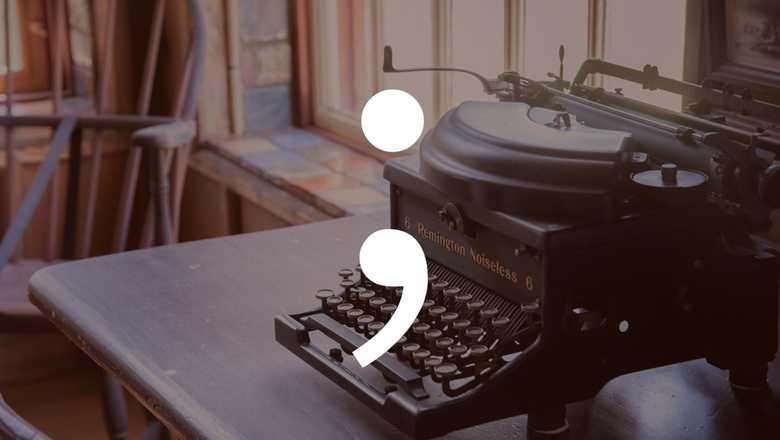What is it about the semicolon that is so alluring to writers?
Is it because it feels like a sophisticated punctuation mark – more advanced than a full stop or a comma – and therefore the mark of a sophisticated writer?
It’s surprisingly easy to fall victim to the semicolon’s charm … until they insidiously infiltrate your writing to the point readers can’t help but get distracted by them. There is such a thing as too many semicolons.
There’s something worse than having too many semicolons in your writing, though, and that’s using semicolons incorrectly. God forbid you do this, because no one will ever forgive you. You’ll forever be branded as a terrible, terrible writer. Everyone will point and laugh, saying: ‘Look at this guy, trying to be all superior and literary and getting it wrong!’ Oh, the sheer audacity! The horror! *swoons in outrageous indignation*
Ah-hem.
Yes, it’s true that too many semicolons can be distracting, and it’s true that incorrectly used semicolons can irk some readers, but don’t get too hung up on the minutia of punctuation. I’m a professional editor and it’s my job to pay attention to these things, but even I know there’s more to a piece of writing than a correctly placed comma (or a correctly used semicolon).
Even so, it doesn’t hurt to consider the most effective ways to use any punctuation mark. Doing so will make you a better writer, enabling you to bring deliberate clarity, rhythm and emphasis to your writing.
With that in mind, here’s how to use the semicolon.
1. Use a semicolon to divide two closely related sentences
Butcher’s Copyediting, the Penguin Guide to Punctuation and New Hart’s Rules all say the same thing about semicolons: ‘It divides two or more main clauses that are closely related or parallel to each other, and that could stand as sentences in their own right.’ (New Hart’s Rules)
This is the most fundamental rule around semicolons.
Whatever is either side of the semicolon must make sense as its own sentence. And you only want to use a semicolon to connect sentences that are closely related, to draw attention to the relationship between the sentences.
Happy families are all alike; every unhappy family is unhappy in its own way.
Leo Tolstoy, Anna Karenina
The past is a foreign country; they do things differently there.
LP Hartley, The Go-Between
She plants a fierce kick against the door; it leaves a dirty boot print but barely vibrates the heavy hinges.
Isaac Marion, The Burning World
If you follow this rule, you can’t go too wrong. Yet there’s a bit more to the semicolon than this.
You may have noticed when reading the examples above that when you came to the semicolon in the sentence, you naturally paused a little longer than you would have for a comma yet a little less than you would have for a full stop. In this way, a semicolon can alter the rhythm of a sentence.
That’s something to keep in mind.
2. Use a semicolon to bring clarity to a convoluted sentence (as the ‘super-comma’)
The first usage is mostly about suggesting meaning and creating rhythm, but the semicolon can also be used to bring much-needed clarity to a long or complicated sentence.
According to the Penguin Guide to Punctuation, this is the ‘one special circumstance in which a semicolon may be used to separate sequences which are not complete sentences.’
New Hart’s Rules says, ‘In a sentence already subdivided by commas, use a semicolon instead of a comma to indicate a stronger division.’
Compare the following examples:
In East London, where the zombie infestation is at a critical level, the army, in spite of its most coordinated efforts, has been unable to extract the remaining citizens, and the people, starving, terrified and desperate, are themselves turning to cannibalism to survive.
Using a semicolon in place of the comma that marks the biggest break in the sentence would allow readers to catch their breath and more easily separate the different points expressed in this sentence.
In East London, where the zombie infestation is at a critical level, the army, in spite of its most coordinated efforts, has been unable to extract the remaining citizens; and the people, starving, terrified and desperate, are themselves turning to cannibalism to survive.
The Penguin Guide goes on to say that this use of the semicolon as a ‘super-comma’ is pretty clunky and should be avoided if possible. If you end up writing a sentence like the one above, recasting the sentence might be the more elegant solution.
In East London, where the zombie infestation is at a critical level, the army has been unable to extract the remaining citizens, in spite of its most coordinated efforts. Meanwhile, the people – starving, terrified and desperate – are themselves turning to cannibalism to survive.
If you find you’re using lots of semicolons as ‘super-commas’ to try to break up your sentences, it’s probably a sign that you’re writing too many convoluted sentences.
3. Use a semicolon to separate elements in a list where each element contains commas
This is another way semicolons are used for clarity. ‘In a list where any of the elements themselves contain commas, use a semicolon to clarify the relationship of the components,’ says New Hart’s Rules.
The most effective way to kill a vampire is by drenching them in holy water, water infused with garlic or petrol (and setting them alight); piercing their heart with a wooden stake made of oak, beech or yew; exposing them to sunlight, fire or holy images; or starving them of blood until they turn to dust.
The Flexibility of Fiction (or How to Bend the Rules)
One of the best things about fiction is that we can sometimes disregard the rules in the name of style and effect. Fragment sentences? Why not. Sentences starting with a connecting word? Throw them in. They all have their place.
And because fiction uses fragment sentences and sentences starting with connecting words (‘and’, ‘but’, ‘so’, ‘yet’, ‘or’, ‘nor’ and ‘for’), it makes sense that semicolons can be used to connect these kinds of sentences. It’s a kind of meta-logic. Broken rules within broken rules.
A pause; it ended horribly.
F Scott Fitzgerald, The Great Gatsby
Fog in the eyes and throats of ancient Greenwich pensioners, wheezing by the firesides of the wards; fog in the stem and bowl of the afternoon pipe of the wrathful skipper, down in his close cabin; fog cruelly pinching the toes and fingers of his shivering little ’prentice boy on deck.
Charles Dickens, Bleak House
Where I would have been happily confined to my office, deep in the School of English with a view to the red brick wall of the window well, content to grub about in dusty corners, there is now this breadth of vision, this depth and freshness to each breath, this widening space; only her and the horizon.
Amy Sackville, Orkney
The key, as with any time you break a grammar rule, is knowing that you’re doing it and doing it with purposeful deliberation. As always, keep in mind clarity, rhythm and emphasis when playing with punctuation.
Semicolons in Dialogue
Some people break into a sweat just thinking about whether it’s okay to use semicolons in dialogue. I used to lay awake at night worrying about this, until I realised it’s okay to be chilled out about these things. (I’m kidding – I’m never chilled out.)
The argument against using semicolons in dialogue is that no one actually tries to deliberately convey a semicolon when they speak. That would be a bit weird. As well as that, a semicolon is more of a visual marker than an audible one. The cherry on top is that it can look a bit pretentious.
AND YET.
Even if you aren’t deliberately trying to convey a semicolon when you talk, the rhythm of speech still might be best represented by a semicolon over a comma or a full stop. (The length of the pause created by a semicolon is somewhere between these two punctuation marks, remember?)
As well as that, you – as the author – might want to highlight the connection between two spoken sentences. And as for that cherry, well, maybe you want your character to seem a little pretentious (or educated or intellectual or …).
Here’s a line of dialogue spoken by Dumbledore, for instance:
Lord Voldemort liked to collect trophies, and he preferred objects with a powerful magical history. His pride, his belief in his own superiority, his determination to carve for himself a startling place in magical history; these things suggest to me that Voldemort would have chosen his Horcruxes with some care, favouring objects worthy of the honour.
JK Rowling, Harry Potter and the Half-Blood Prince
When to Use a Semicolon and When to Use a Colon
Because of the flexible nature of fiction, some writers end up using a semicolon when a colon would be a more logical choice.
‘A colon is used to indicate that what follows it is an explanation of elaboration of what precedes it,’ says the Penguin Guide to Punctuation. ‘A colon is nearly always preceded by a complete sentence; what follows the colon may or may not be a complete sentence, and it may be a mere list or even a single word.’
New Hart’s Rules summarises that the colon ‘points forward: from a premise to a conclusion, from a cause to an effect, from an introduction to a main point, from a general statement to an example.’ And that sentence perfectly illustrates its own point.
My loathings are simple: stupidity, oppression, crime, cruelty, soft music.
Vladimir Nabokov, Strong Opinions
These were rituals that were right and lasting: the lighting of pipes, the pale hands that moved knitting needles in the dimness, the eating of foil-wrapped, chill Eskimo Pies, the coming and going of all the people.
Ray Bradbury, Dandelion Wine
If I loosed my eyes from my shoes, the gravel at my feet, or the chaos of ice at the shore, I saw what newborn babies must see: nothing but senseless variations of light on the retinas.
Annie Dillard, Teaching a Stone to Talk
There’s even more to the colon, but for now I just want to highlight the basic difference between semicolons and colons. In general, the semicolon links two closely related sentences whereas the colon indicates a deepening in meaning (in the ways New Hart’s Rules lists above).
If in Doubt, Use Sparingly … and Leave it to Your Editor
Semicolons can trip up a lot of writers, but I hope this post has shed some light on the rules around their usage – and when and how you can break those rules.
I want to reiterate that semicolons (and colons) should be used sparingly in your fiction because if there are lots of them, they stand out to the reader and pull their attention away from the story. Obviously, that’s a bad thing.
If you’re still not sure whether you’re using semicolons right, don’t worry too much. You could choose to not use them at all (lots of novels don’t contain a single semicolon). But, as always, your editor will help you out.





